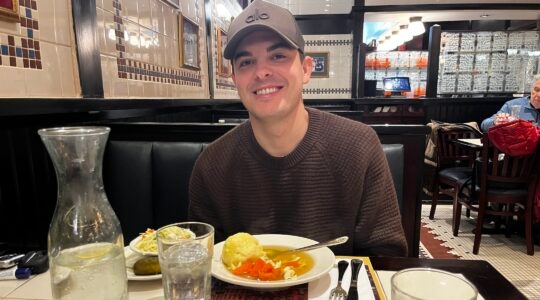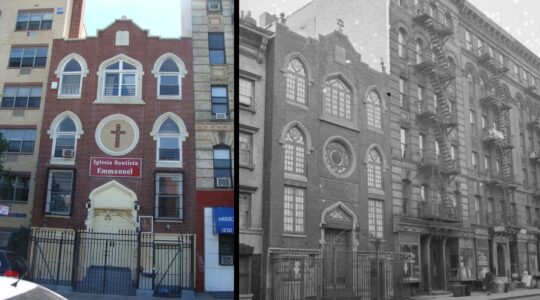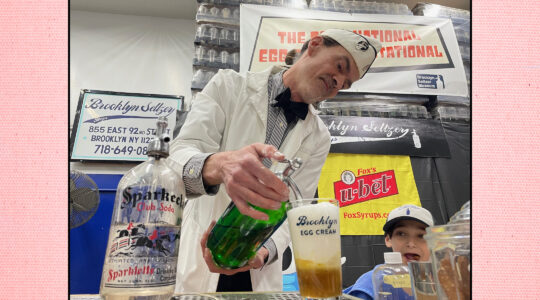The case is sometimes made that when it comes to telling truths about Israel — be they good, bad or ugly — it’s probably best to have a Jew do it. But Kehinde Wiley, a gay black artist from South Central Los Angeles, may be offering the definitive rebuke to that notion.
His new exhibit at The Jewish Museum, which opened this month, features 14 enormous, princely portraits of Israelis — Ethiopian Jews, Ashkenazis and Arabs. Yet what strikes you first is not the subjects’ differences, but what they all share: a defiant self-confidence rooted in hip-hop culture.
“It’s all about breaking down assumptions that we carry,” Wiley, 35, told The Jewish Week in a recent interview. “What I wanted to do with [my] Israel [series] is go beyond the political realm and key in on some of the emotional aspects — what does it mean to be an Israeli on the streets of Tel Aviv today?”
The Israel series is part of a larger series of portraits Wiley has made of young urban men around the globe. Titled “The World Stage,” Israel is Wiley’s fifth stop on a world tour that had already taken him to Brazil, West Africa, China and India. He chose Israel, he said, for the central role the country, and the Middle East, play in America today.
“It’s quite clear that Israel is important to America and the region,” he said, referring to the Middle East. “But I wanted to get a different perspective about it. … It was an opportunity for me to learn more.”
He picked Israel as one of his destinations for “The World Stage” series two years ago, just before the Arab Spring. He spent a month in the country’s clubs, bars and hip urban hangouts looking for possible subjects to paint. After taking hundreds of photos of Israelis, he ultimately selected 18 to paint. (Four portraits are excluded from the exhibit.)
What he looked for in his subjects was “a kind of swagger,” he said, “you know it when you see it.”
The Arab Spring erupted before he began painting, but it only convinced him that his choice of Israel was prescient. Even though Israel is one of the few countries not to have been upended by revolution, he could detect an insubordinate spirit among many of the marginalized Israelis he met.
“With the Arab Spring we’re starting to see a yearning for leadership that goes beyond tyrannical dictatorship,” he said. “You see that that in the youth culture throughout the Middle East [including Israel]; we all want the same thing.”
Indeed, it can be startling to see portraits of Israeli men who might otherwise be political adversaries — Arab and Jew; black and white — look so strangely alike.
“I love that about the work,” said Karen Levitov, a curator at The Jewish Museum who organized the Wiley exhibit. “You don’t know just by looking at them if they’re Jewish or Arab, or Israeli or not. … If you saw these people on the streets of New York, you wouldn’t think twice.”
The similarities are not only reflected in the subjects’ similar urban dress, now a ubiquitous global phenomenon. They are reflected in Wiley’s aesthetic style. Like he has being doing for much of his career, he paints his men against richly colored backgrounds, inspired here by traditional Arab and Jewish designs.
For research, he looked to Jewish folk art like paper-cuts and Torah ark tapestries, later selecting centuries-old examples owned by The Jewish Museum to be displayed alongside his paintings. For the backgrounds of Arabs and Ethiopian Jews, he studied Arab ornamentation and traditional Ethiopian motifs.
Looking at his portraits side by side, the cultural borrowing becomes obvious. Rococo curls, snaking, vine-like patterns, and beastly images of goats, lions and birds are common tropes throughout.
But Wiley was not only interested in complicating the narrative of conflict that seems to define Israel. He wanted to learn more about how race — a steady focus throughout his career — affects social relations beyond America’s borders. That in part explains why so many of these portraits, about two-thirds, are of Ethiopian Jews, many of whom immigrated to Israel during the airlifts of the mid-1980s and ’90s.
“I would ask them, point-blank: Do you feel Israeli? Or do you feel African?” Wiley explained. The answer “was as varied as the people,” he said.
For Ethiopian Jews like Solomon Mashash, painted here in a gold T-shirt with two leaping leopards, racism is a pervasive problem. “It’s very hard to be a black person in Israel,” we hear Mashash say in short documentary on view in the exhibit.
But for other Ethiopian Jews like Kalkidan Mashasha, a rapper in Israel who became something like Wiley’s tour guide, his religious identity seems to jostle for attention with his national and racial ones. “I’m proud to be Jewish,” he raps, in lyrics printed in the exhibit’s catalog. “And are you proud to be Israeli?” he continues, without ever answering.
The catalog offers a fuller portrait of Mashasha and the shifting sands of his identity. His father was imprisoned and tortured for helping Ethiopian Jews escape to Israel in the 1980s. By the time Mashasha and his family made it to Israel in 1989, his father was too disabled to work; Mashasha grew up poor.
Though he won a scholarship to Hebrew University, which he attended during breaks in military service, Mashasha never felt fully Israeli. So in 2008, having saved up money from his time working on a kibbutz, he took a heritage tour to Ethiopia. The trip was eye opening: “It was there that I understood that I was an Israeli,” he says in the catalog.
Wiley says that learning about how Ethiopians felt in Israel complicated his own views about race. “The whole black-white dichotomy has to get thrown out the window when you’re outside of America,” he explained. Though he was fully aware of the nuances of race within America and within the black community, he saw how nationality and religion could complicate things even further.
But don’t mistake Wiley’s work for being about race alone. While race remains central, he is equally interested in the construction of identity, gender and in upending traditional assumptions about art.
“This idea that my work is about hip-hop is a little reductive,” Wiley said, alluding to critics who often discuss his work solely in terms of urban black culture. “What I’m interested in is the performance of masculinity, the performance of ethnicity, and how they intermingle across cultures.”
Shortly after graduating from Yale’s MFA program in 2001, Wiley took the art world by storm, all while thumbing his nose at its notions of beauty.
Since the birth of the avant-garde in the early 20th century, luxuriant, aristocratic portraits like those favored by Wiley have fallen out of fashion. Even post-war figurative painters like Lucien Freud, say, and present-day practitioners like Lisa Yuskavage and George Condo, who are celebrated for their grand, large-scale oil portraits, have found success by deliberatively courting the grotesque.
But Wiley’s success — his paintings have been acquired by more than 40 museums, including the Metropolitan Museum of Art, the Los Angeles County Museum of Art and, now, The Jewish Museum — has been predicated on the idea that old-fashioned notions of beauty can again be taken seriously — yet only as long as the subject is changed.
His subjects, usually urban black youth, challenge unchecked assumptions we might have of what classical portraiture can be. These marginalized black men are meant to look just as breathtaking on museum walls as a white Catholic priest, or a European prince, Wiley says.
“My work is trying to come to terms with that tradition,” he said.
Whether his subjects are urban black rappers, gay men, Arab, Ashkenazi or Ethiopian Israelis, Wiley’s effort to revivify classical portraiture continues. “I want to change the subject, and allow for a level of freedom that is probably even impossible.”
“Kehinde Wiley / The World Stage: Israel” is now on view at The Jewish Museum through July 29. The museum is located at 1109 Fifth Ave., at 92nd St. Call (212) 423-3200 for more information.
The New York Jewish Week brings you the stories behind the headlines, keeping you connected to Jewish life in New York. Help sustain the reporting you trust by donating today.




